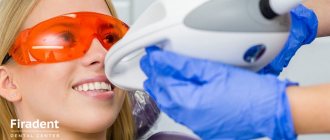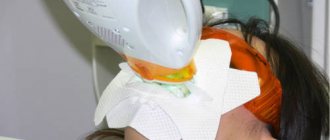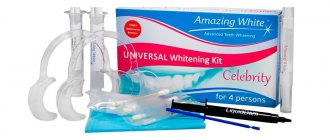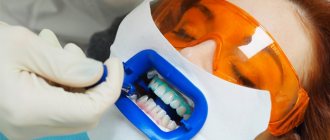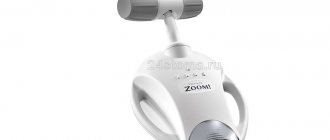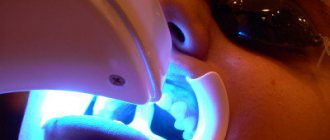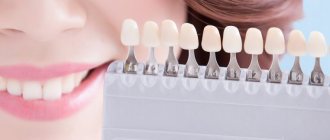From this article you will learn:
- Zoom teeth whitening technology
- How to prepare for teeth whitening
- How is the procedure performed?
- Recommendations after teeth whitening
- Harm of teeth whitening
- Whitening price
Teeth whitening in dentistry is divided into conservative and reconstructive. The latter is one in which the aesthetics of a smile is improved by filling teeth or prosthetics with veneers or lumineers. These methods are indicated when there are various stains or defects against the background of unchanged dental tissue. Conservative methods are represented by chemical, laser, and ultrasound procedures. They do not require tooth preparation or the manufacture of microprostheses, and can improve the shade of teeth by up to 12 tones.
Teeth whitening using the zoom system is a laser conservative method of enamel lightening.
With age, each person's enamel begins to darken. Also, its shade is negatively affected by the consumption of certain coloring products (coffee, tea, wine and other drinks and food with dyes), and smoking. The color of the enamel may be determined by heredity. It may be grayish or yellowish. Its color can also be affected by taking various medications, as well as intoxication with heavy metals.
If you are unhappy with the shade of the enamel of your teeth, this cosmetic flaw is harmful to your self-esteem and peace of mind, this is a fairly strong indication for teeth whitening zoom 4. It is very important to choose a good dentist, with experience - in this case, you will be given the correct preparation, the procedure itself will not will have flaws, and you will receive the right recommendations that will help prolong the effect of teeth whitening with a zoom lamp.
Features of teeth whitening Zoom 4
Zoom technology is patented by Discus Dental. The essence of the method is as follows: a special gel is applied to the surface of the teeth, the action of which is activated by the light of an ultraviolet lamp. As a result of light exposure, oxygen molecules are released, which penetrate dental tissue and destroy coloring pigments.
Zoom 4 whitening technology, which is the latest version of Philips' development, features a number of solutions that significantly increase the comfort and safety of the procedure.
Content:
Zoom 4 is an updated technology of one of the most popular professional teeth whitening systems from Philips. The improved system is considered the safest compared to previous ones, as it contains 10% less hydrogen peroxide (only 25%). The developers of the updated Zoom 4 system managed to find the optimal balance between the effectiveness and safety of whitening. Thanks to this, tooth enamel does not deteriorate or crack.
Zoom 4 is the most effective and safe teeth whitening technology available today. The Zoom 4 technology showed the greatest whitening effect when the enamel darkened due to smoking or consumption of food coloring. The Zoom whitening technique was created in the USA, and, thanks to its many advantages, very soon became popular in other countries.
Benefits of Philips Zoom 4 Teeth Whitening
The most effective and gentle whitening - under this motto, Philips launched its new product on the market. The Zoom 4 kit includes an LED lamp with various intensity settings, Philips ZOOM! Chairside, as well as Relief ACP tooth sensitivity reducer. Previous generation systems have a similar set of components. However, the old composition of the whitening gel could not be called ideal. In Zoom 4 it was seriously improved, which helped reduce the negative impact on dental tissue.
Is Zoom 4 teeth whitening harmful?
Any type of whitening is safe if it is performed by a qualified professional following protocol, as well as certified equipment and supplies.
pros
- The hydrogen peroxide content is 25%, which is the lowest level compared to previous Zoom systems.
- The whitening gel contains calcium phosphate to restore enamel.
- Philips ZOOM! Chairside does not overheat dental tissue and has a flexible system of settings.
- To prevent tooth sensitivity, an effective remedy is used - Relief ACP gel.
- The procedure takes on average no more than 45 minutes.
The whitening procedure itself is carried out in several successive stages:
- A two-component gel is applied to the “smile zone” (10 lower and 10 upper dental units). It contains hydrogen peroxide and an alkaline component;
- exposure is carried out using a UV lamp. This allows the hydrogen peroxide activity to start. Duration of exposure – 15-20 minutes;
- after this period, the teeth are processed again if the desired result is not achieved. In the vast majority of cases, two applications are sufficient;
- At the last stage, the teeth are treated with a remineralizing gel. It contains amorphous calcium phosphate, which restores enamel and reduces sensitivity.
The clinic employs highly qualified specialists who take prizes in All-Russian competitions.
They have enormous experience and practical skills in solving problems of varying complexity.
Differences between Zoom 4 and Zoom 3
There are no conceptual differences between two generations of the same technology. It's all about the nuances.
✔
Firstly, all components and tools of Zoom 4 are from one manufacturer. Their maximum compatibility allows you to achieve the best results.
✔
Secondly, the Zoom 4 whitening gel contains a number of additional elements that reduce the negative impact on the enamel and promote its active restoration.
✔
In addition, Zoom 4 contains less hydrogen peroxide: 25% versus 35% in Zoom 3. This ten percent difference is very important. The alkaline composition, which is applied along with the gel, helps to minimize this impact.
Thanks to the balanced composition and the introduction of new developments, hypersensitivity after teeth whitening with the Zoom 4 system can be observed for only 7-10 hours, after which the patient practically does not feel any serious discomfort. In terms of safety, comfort and painlessness, Zoom 4 is superior to Zoom 3, not to mention earlier systems. On the other hand, the efficiency of Zoom 3 is about the same as that of Zoom 4.
Carrying out the procedure
The principle of whitening is to apply a gel with a concentration of hydrogen peroxide to the surface of the enamel. Depending on the whitening technique, preparations with different concentrations of hydrogen peroxide are used: Zoom 1 2 3 - 35%, Zoom 4 - 25%.
Before the procedure, the dentist examines the oral cavity, assesses the condition of the dental system, and determines the initial shade of the teeth. Doctors at the Mitino Dental Center recommend professional teeth cleaning to remove hard and soft plaque before teeth whitening.
The Zoom whitening procedure takes place in several successive stages:
- The lips and gums are treated with protective agents and isolated from the teeth with a rubber dam (latex plates).
- Tooth enamel is coated with a special Zoom compound and activated with an LED lamp. A cold light source prevents overheating of soft tissues. The stages of application and illumination are repeated three times. At each stage, the gel should remain on the teeth for no more than 10–15 minutes.
- The remaining gel is removed with cotton swabs, the teeth are washed with water, dried, the rubber dam is removed, and a remineralizing gel is applied.
When teeth are stained after nerve removal and canal filling, intracoronal bleaching is performed. In this case, a special cavity is filled with Zoom whitening gel and a temporary filling is installed. The pigment breaks down within 10–14 days, after which the temporary filling is replaced with a permanent one. The technique is applied to individual dental units, and not to the entire row.
How does whitening with the Zoom 4 system work?
For the procedure to be effective, preparation for Zoom 4 teeth whitening involves professional hygiene. In order to prevent increased sensitivity of teeth, remineralizing therapy is also carried out in combination with brushing. One whitening session can consist of several cycles of 10-15 minutes. After whitening, Relief gel is applied to the enamel to reduce tooth sensitivity.
Cost of the zoom system
To give teeth natural whiteness using Zoom 3 technology, the patient will have to pay $129 .
However, this price is completely justified. If the teeth whitening procedure is carried out by a professional specialist, then the patient can expect that he will not only receive beautiful snow-white teeth, but will also improve his oral health, because this technology requires professional cleaning before the whitening procedure. At the same time, anyone can perform the procedure themselves at home using strengthening whitening gels. In this case, the cost of whitening can be reduced by 2 times, but to ensure the best result, the procedure must be carried out under the supervision of a dentist.
Whitening results
Several factors influence how bright and light the shade of your teeth will be. The first is smoking. The more cigarettes a patient smokes, the sooner the teeth will darken from nicotine stains. To prevent this from happening, you should either give up the bad habit or regularly undergo professional cleaning.
The second factor is the innate shade of the enamel. There are 16 of them in total, and there are teeth that are very dark by nature. The darker the natural pigment, the more effort you will have to put into bleaching.
The third factor is illness or taking medications that affect the color of teeth (fluorosis, tetracycline antibiotics, etc.). Such stains may be difficult to whiten. The whitening result will last from 3 to 5 years, provided proper and regular care (home hygiene, professional cleaning every six months).
Preparation
The Zoom whitening procedure takes very little time, about an hour and a half. Be sure to properly prepare for it:
- about two weeks before this procedure, many patients and dentists recommend using a special Fluoridex toothpaste when cleaning their teeth, which can reduce tooth sensitivity;
- It is imperative to eliminate all kinds of dental diseases. It is recommended to eliminate bleeding gums, after which you can begin to whiten the enamel;
- In about two weeks, it is worth having a professional teeth cleaning, during which the stone will be completely removed from the surface of the teeth.
Care and diet after teeth whitening Zoom 4
Any type of bleaching imposes a number of restrictions, the compliance with which directly determines the effectiveness of the procedure. In the case of Zoom 4 technology, it is very important to follow a diet after whitening is completed.
List of recommendations after whitening Zoom 4
- Eliminate from your diet all foods and drinks that tend to stain your teeth. First of all, these are coffee, tea, sweet carbonated drinks, wine, beets, carrots, ketchup and dark chocolate. It is advisable to avoid the above foods for at least a week.
- For two days, completely eliminate tobacco use. It is advisable to quit smoking for a month or at least significantly reduce the number of cigarettes per day.
- Comprehensive hygiene using floss, irrigator, high-quality toothbrush and toothpaste with minimal abrasiveness (at least during the recovery stage after whitening).
- Regular visits to the dentist for preventive examinations and professional hygiene.
Advantages and disadvantages
Although you can find many conflicting reviews about this system on the Internet, in reality, whitening using the zoom method does not have a destructive effect on tooth enamel and gum tissue. The only thing that cannot be doubted is that it is a very specific procedure . It can only be done with teeth that are in perfect condition. Unfortunately, the Zoom system cannot change the color of crowns, so after whitening they may look different from the rest of your teeth. It is also necessary to take into account the contraindications of the Zoom whitening system: women during pregnancy, people with allergies, and smokers should avoid it.
About the harmfulness of the procedure
It is believed that bleaching seriously damages the enamel, causing its destruction, and also negatively affects the condition of the teeth.
A similar point of view is held by dentists who are not ready to accept modern methods of acquiring a beautiful smile, or by people who are practically unfamiliar with the features of the procedure. However, in recent years dentistry has been actively developing , and the whitening procedure is today one of the most popular techniques that helps improve the appearance of a smile. It is in demand by many patients who want to correct various cosmetic dental defects, and often this is where work to improve their smile begins.
Clinics in Europe and Western countries have acquired significant experience in performing whitening procedures. Over the past 30 years, they have been able to adopt many different methods, tools and drugs that are not only very effective, but also have minimal harm to the condition of the teeth. But we must not forget that this is an aesthetic procedure, and therefore specialists must follow certain rules. The doctor must take into account the degree of impact, frequency, and individual characteristics of the patient. All this helps to make such a service as safe as possible.
Contraindications
The whitening procedure is recommended primarily for those people who want to eliminate a certain cosmetic defect in their teeth. But, unfortunately, the patient’s desire to undergo this procedure is not enough for the doctor to agree to it. First of all, he should conduct an examination of the oral cavity , since some patients may have contraindications for teeth whitening.
Experts call the following main contraindications:
- Signs of caries, which may require oral sanitation;
- The presence of many large, visible old fillings that need to be replaced;
- The presence of crowns and dentures on the smile line, which is why they can look very different from whitened teeth;
- Periodontal diseases;
- Thin and weak tooth enamel;
- Increased sensitivity of teeth;
- Allergy to the components of the whitening gel;
- Oncological diseases;
- Chemotherapy treatment;
- Pregnancy and breastfeeding;
- Age up to 18 years;
- Active smoking.
The specialist will have to determine whether the patient has contraindications during the initial consultation . In some cases, certain contraindications can be eliminated. Then the dentist must draw up a treatment plan, after which, if it is successfully implemented, you can proceed directly to the whitening procedure.
